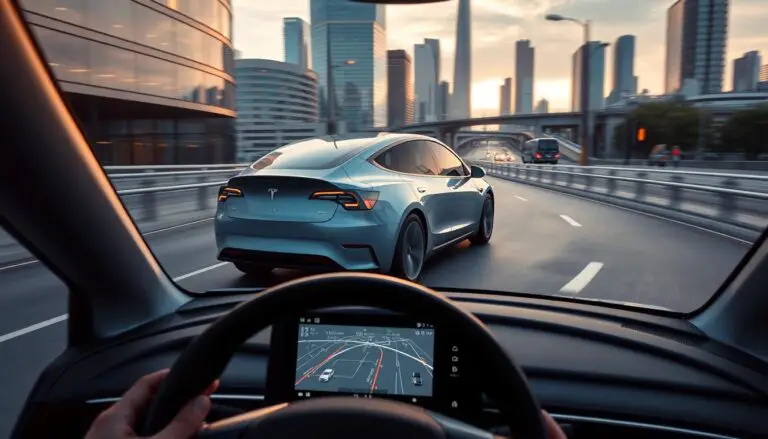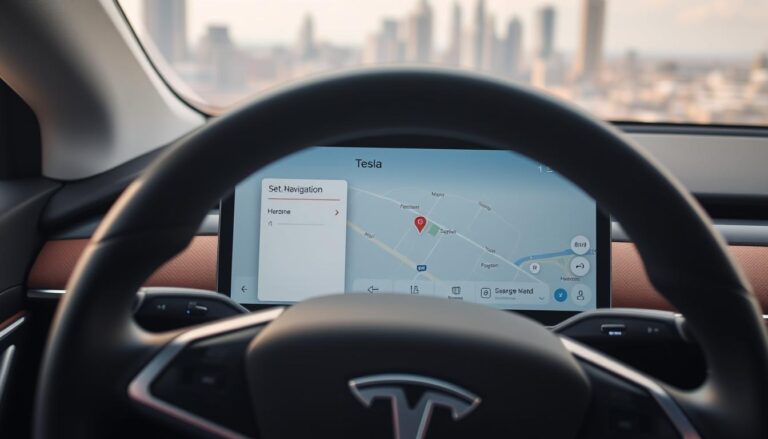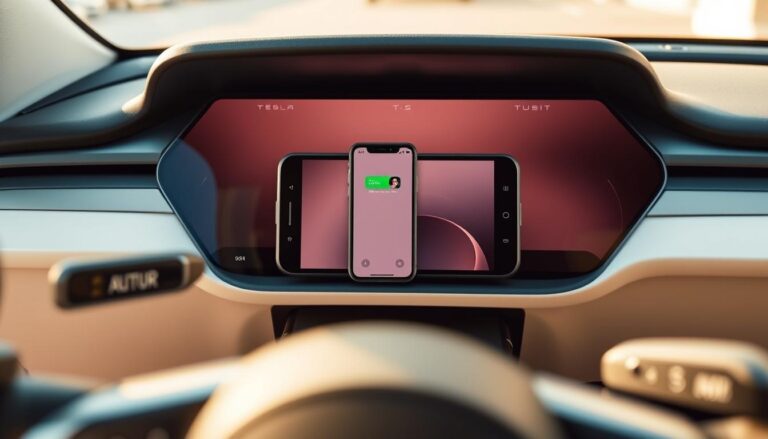A functioning navigation system is crucial for Tesla owners, providing accurate directions and enhancing the overall driving experience. However, users often encounter issues with their Tesla’s navigation, which can be frustrating and disrupt their journeys.
Common problems include inaccurate location tracking, failure to update maps, and unresponsive touchscreens. In this article, we will explore the common causes of these Tesla navigation issues and provide practical tips and tricks for troubleshooting them.
Key Takeaways
- Understand the importance of a functioning navigation system in Tesla vehicles.
- Identify common issues with Tesla navigation.
- Learn practical tips for troubleshooting Tesla navigation problems.
- Discover how to resolve common navigation issues.
- Improve your overall Tesla ownership experience.
Understanding Tesla’s Navigation System
Understanding how Tesla’s navigation system works is crucial for troubleshooting issues such as “Tesla navigation not working” or “Tesla navigation problems.” Tesla’s navigation is more than just a GPS; it’s a sophisticated system that integrates various technologies to provide a seamless driving experience.
How Tesla Navigation Works
Tesla’s navigation system uses a combination of GPS, mapping data, and software to provide turn-by-turn directions. It also offers real-time traffic updates, helping drivers avoid congested areas and reduce travel time. For more information on troubleshooting navigation issues, you can refer to guides on resetting your Tesla’s screen, which may help resolve related problems.
Key Components of Tesla Navigation
The key components include high-resolution mapping data, GPS connectivity, and advanced software that processes data in real-time. These components work together to ensure that the navigation system provides accurate and up-to-date information.
Differences Between Tesla Models
While the core navigation system is similar across Tesla models, there are differences in the user interface and features. For example, newer models may have more advanced navigation features, such as improved traffic prediction and more detailed maps.
Latest Updates and Features
Tesla continuously updates its navigation system to improve performance and add new features. Recent updates have included enhancements to traffic prediction and the addition of new points of interest. Staying up-to-date with the latest software ensures that Tesla owners have the best possible navigation experience.
Tesla Navigation Not Working (Reason and How to Fix It)
If your Tesla’s navigation is not working, identifying the root cause is crucial for an effective solution. Tesla’s navigation system is a complex feature that relies on a combination of software, hardware, and connectivity to function properly.
Common Causes of Navigation Failures
Tesla navigation failures can be attributed to several factors. Understanding these causes is the first step towards resolving the issue.
- Software-related issues
- Hardware-related problems
- Connectivity issues
Software-Related Issues
Software plays a critical role in Tesla’s navigation system. Issues in this area can lead to navigation failures.
Outdated Software Versions
Using an outdated software version can cause compatibility issues and affect navigation performance. Ensuring your Tesla’s software is up-to-date is essential. To update, go to the settings menu, select “Software Update,” and follow the prompts.
Map Data Corruption
Corrupted map data can lead to incorrect navigation directions or a complete failure of the navigation system. Clearing the navigation cache can sometimes resolve this issue.

Hardware-Related Problems
Hardware issues can also impact Tesla’s navigation system. Identifying and addressing these problems is crucial.
GPS Antenna Issues
A malfunctioning GPS antenna can disrupt the navigation system’s ability to provide accurate directions. Checking the GPS antenna for damage or misalignment is necessary.
MCU Malfunctions
The Media Control Unit (MCU) is a critical component that can affect navigation. If the MCU malfunctions, it may need to be reset or replaced.
Connectivity Issues
Connectivity plays a vital role in Tesla’s navigation, especially for features like real-time traffic updates.
Poor Cellular Connection
A poor cellular connection can impede the navigation system’s performance. Ensuring a stable cellular connection is vital.
Wi-Fi Connection Problems
Wi-Fi connectivity issues can also affect navigation, particularly when relying on Wi-Fi for map updates or other data. Troubleshooting your Wi-Fi connection can help resolve these issues.
By understanding the common causes of Tesla navigation failures and following the appropriate troubleshooting steps, you can often resolve the issue and restore your navigation system’s functionality.
Basic Troubleshooting Steps
Experiencing issues with your Tesla’s navigation system can be annoying, but basic troubleshooting can often resolve the problem. When faced with navigation malfunctions, it’s essential to methodically address potential causes to restore functionality.
Performing a Soft Reset
A soft reset is a simple yet effective troubleshooting step. It involves restarting the Tesla’s system without affecting any saved settings.
Model 3 and Y Reset Procedure
For Model 3 and Y, press and hold both scroll buttons on the steering wheel until the screen turns off and the Tesla logo appears.
Model S and X Reset Procedure
For Model S and X, press and hold both scroll buttons on the steering stalk until the screen goes dark and the Tesla logo reappears.
Checking for Software Updates
Ensuring your Tesla’s software is up-to-date is crucial. To check for updates, navigate to the ‘Software’ section in your Tesla’s settings menu.
- Go to ‘Controls’ on the touchscreen
- Select ‘Software’
- Check if an update is available
Verifying Network Connectivity
A stable network connection is necessary for the navigation system to function correctly. Check your Tesla’s Wi-Fi or cellular connection to ensure it is connected.
| Connection Type | Status |
|---|---|
| Wi-Fi | Connected/Disconnected |
| Cellular | Connected/Disconnected |
Clearing Navigation Cache
Clearing the navigation cache can resolve issues related to outdated or corrupted data. To do this, go to ‘Navigation’ settings and select ‘Clear Cache’.
“Clearing the cache can often resolve navigation issues by removing outdated data,” said a Tesla support specialist.
Recalibrating the GPS
GPS recalibration can help if the navigation system is providing incorrect location information. Drive your Tesla in an open area with a clear view of the sky for a few miles to help recalibrate the GPS.
By following these basic troubleshooting steps, many common Tesla navigation issues can be resolved. If problems persist, it may be necessary to explore more advanced solutions.
Advanced Solutions for Persistent Navigation Problems
If your Tesla’s navigation system continues to malfunction, it’s time to explore more advanced troubleshooting methods. Persistent navigation issues can be frustrating, but there are several steps you can take to resolve them.
Hard Reset Procedures
A hard reset can sometimes resolve persistent navigation problems by restarting your Tesla’s system. To perform a hard reset, follow these steps: press and hold both the scroll buttons on the steering wheel until the screen turns off, then release. This process can take a few minutes and may resolve software-related issues.
Factory Reset Considerations
A factory reset is a more drastic measure that restores your Tesla’s settings to their original state. Before doing this, it’s crucial to back up any important data, as a factory reset will erase all personalized settings. To perform a factory reset, go to Controls > Software > Factory Reset.
When to Contact Tesla Support
If you’ve tried the above solutions and your Tesla’s navigation is still not working, it may be time to contact Tesla Support. They can provide further assistance, diagnose hardware issues, or offer repair options. It’s also a good idea to check if your vehicle is under warranty or if there are any known issues with your specific Tesla model.
Using Alternative Navigation Apps
While Tesla’s navigation is convenient, using alternative navigation apps can be a useful workaround if you’re experiencing persistent issues. Tesla’s infotainment system supports various third-party apps.
Google Maps Integration
Google Maps is a popular alternative for navigation. You can access Google Maps through Tesla’s web browser, providing a reliable fallback option.
Waze and Other Third-Party Options
Waze is another excellent navigation app that provides real-time traffic updates. Other third-party navigation apps can also be used, offering various features and functionalities.
Preventative Maintenance Tips
Regular maintenance can help minimize the occurrence of navigation issues. Ensure your Tesla’s software is always up to date, as updates often include bug fixes and improvements. Additionally, maintaining a stable internet connection can help prevent connectivity-related navigation problems.

| Solution | Description | Benefits |
|---|---|---|
| Hard Reset | Restart Tesla’s system by pressing and holding the scroll buttons on the steering wheel. | Resolves software-related issues, quick and easy. |
| Factory Reset | Restore Tesla’s settings to their original state. | Erases personalized settings, resolves deep-seated software issues. |
| Alternative Navigation Apps | Use Google Maps, Waze, or other third-party navigation apps. | Provides a reliable fallback, offers various features and functionalities. |
Resolving Tesla Navigation Issues
Troubleshooting Tesla navigation problems requires a comprehensive understanding of the system’s components and functionality. By following the steps outlined in this article, Tesla owners can effectively resolve navigation issues and optimize their driving experience.
To recap, understanding how Tesla’s navigation system works, identifying common causes of navigation failures, and performing basic troubleshooting steps can help resolve most issues. For persistent problems, advanced solutions such as hard reset procedures and contacting Tesla support may be necessary.
By applying these Tesla navigation tips, owners can ensure a seamless navigation experience. Regular software updates and preventative maintenance can also help prevent navigation issues from arising in the future, making the most of Tesla’s navigation capabilities.
FAQ
Why is my Tesla navigation not working after a software update?
If your Tesla navigation is not working after a software update, it may be due to a temporary glitch or map data corruption. Try performing a soft reset or checking for further software updates to resolve the issue.
How do I update the maps on my Tesla navigation system?
Tesla navigation maps are updated through software updates. To update your Tesla’s navigation maps, go to the ‘Software Update’ section in your vehicle’s settings and check for available updates. Install the latest update to ensure you have the most current maps.
Can I use Google Maps on my Tesla instead of the built-in navigation?
Yes, Tesla vehicles support Google Maps integration through the Tesla infotainment system. You can access Google Maps by using the ‘Theater’ or ‘Entertainment’ mode and then navigating to the Google Maps app. Alternatively, you can use third-party navigation apps like Waze.
Why does my Tesla navigation keep losing signal or freezing?
If your Tesla navigation is losing signal or freezing, it could be due to poor cellular connection, GPS antenna issues, or software glitches. Try verifying your network connectivity, recalibrating the GPS, or performing a soft reset to resolve the issue.
How do I perform a soft reset on my Tesla to fix navigation issues?
To perform a soft reset on your Tesla, press and hold both scroll buttons on the steering wheel for Model S and X, or press and hold the two scroll buttons on the steering yoke for Model 3 and Y, until the screen turns black and the Tesla logo appears.
What should I do if none of the troubleshooting steps resolve my Tesla navigation issue?
If none of the troubleshooting steps resolve your Tesla navigation issue, it is recommended to contact Tesla support for further assistance. They can help diagnose the problem and provide a solution or schedule a service appointment if necessary.


